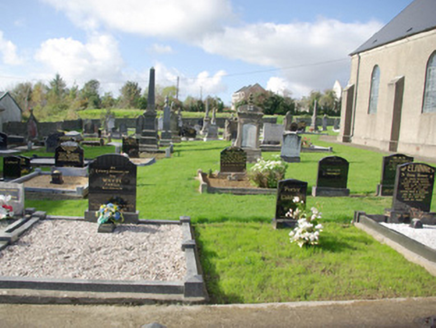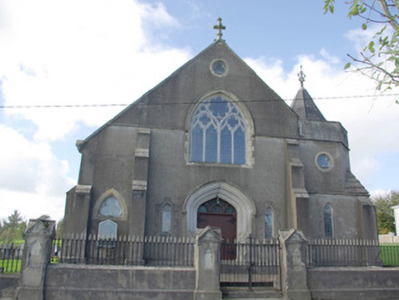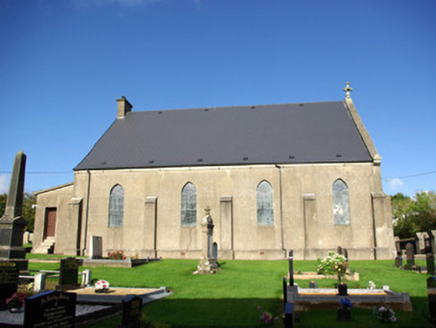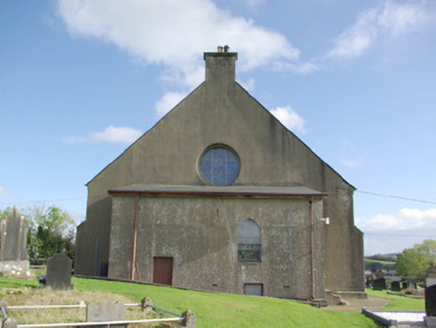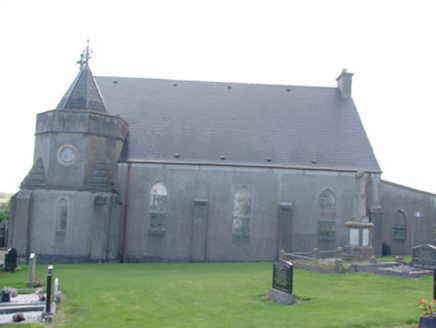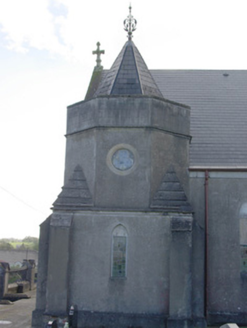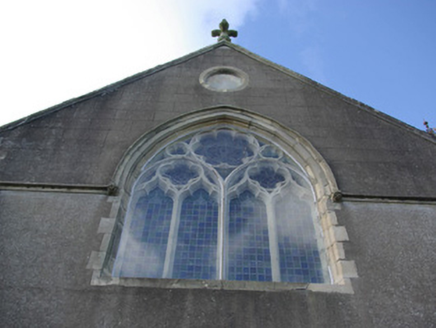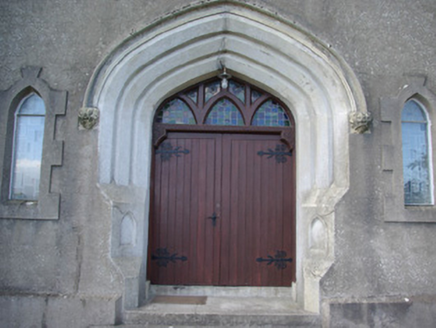Survey Data
Reg No
40832015
Rating
Regional
Categories of Special Interest
Architectural, Artistic, Social
Original Use
Church/chapel
In Use As
Church/chapel
Date
1900 - 1910
Coordinates
221582, 401504
Date Recorded
16/10/2007
Date Updated
--/--/--
Description
Detached four-bay single-storey gable-fronted Presbyterian church/meeting house, built 1903, with offset two-stage tower/stair tower attached to the north corner of the entrance front (east) having first stage on square-plan with second stage over on octagonal-plan. Single-storey vestry attached to the west elevation. Pitched artificial slate roof to main body of building having raised render coping to the front (east) with decorative cut stone (?) finial over gable apex and with kneeler stones at eaves level having gable-fronted blocks over; rendered chimneystack to the west end of main body of building; rendered eaves course to the north and south elevations. Hipped artificial slate roof on octagonal-plan to tower, partially hidden behind raised rendered and ruled-and-lined parapet, having lead flashing and with decorative wrought-iron finial over. Mono-pitched artificial slate roof to vestry. Smooth rendered and smooth rendered ruled-and-lined walls over projecting rendered plinth course and with stepped clasping buttresses between bays to side elevations of main body of building (north and south) having feathered skews/coping, stepped clasping buttresses to corners of front elevation (east) and to either side of main doorway having feathered skews/coping. Moulded render stringcourse to front elevation. Moulded render stringcourse to tower, delineating stages; angled feathered skews to corners of tower at second stage level. Pointed-arched window openings to side elevations (north and south) of main body of building and to the north elevation of tower at first stage level having leaded coloured glass windows; pointed-arched window openings to front elevation (east), flanking doorway, having raised rendered block-and-start surrounds with chamfered reveals, and with leaded coloured glass windows; trefoil window openings to the south end of the front elevation (east), below gable apex to the front elevation, and to the east and north elevations of tower at second stage level, having chamfered ashlar surrounds (generally round, triangular surround to the window opening to the south end of the front elevation), cut stone tracery and with leaded coloured glass windows; four-light pointed-arched window opening over main doorway to front elevation having cut stone Decorated Gothic tracery with geometric motifs, chamfered ashlar surround, leaded coloured glass windows, and with hoodmoulding over with decorative label stops; round window opening to west gable end having leaded coloured glass windows. Tudor-arched/four-centred arched doorway to the centre of the east elevation having splayed render surround with projecting splayed render blocks to base having inset pointed-arched recesses, timber double-doors with decorative wrought-iron hinges, haunched timber lintel with craved detailing, overlights with timber tracery and leaded stained glass, and with hoodmoulding over having decorative label stops. Set slightly back from road in own grounds to the north-east of the centre of Convoy, and adjacent to the north of the associated Presbyterian hall (see 40832014), dated 1910; graveyard to site having mainly twentieth-century memorials. Bounded on street-frontage to the east by rendered boundary wall having wrought-iron railings over with decorative finials, and with rendered gate piers (on square-plan) along length having recessed pointed-arch motifs to front faces and rendered capstones over with four gable-fronted faces having recessed trefoil motifs. Gateway to the centre, serving main doorway, having a pair of rendered gate piers (on square-plan) having recessed pointed-arch motifs to front face, rendered capstones over with four gable-fronted faces having recessed trefoil motifs, and with a pair of wrought-iron gates. Rubble stone to other site boundaries. Possible remains of former sexton’s house or manse to the north-west of site.
Appraisal
This Presbyterian church/meeting house retains much of its early form, character and much of its fabric despite some modern alterations including the replacement of the roof. The pointed-arched openings give this built a Gothic Revival character that is typical of its type and date in Ireland. Of particular significance is the well-detailed main elevation to the east, which is enlivened by the wide window opening with intricate cut stone Decorated Gothic tracery, the wide Tudor-arched doorway and the pronounced finial to the gable apex that together create a strong central focus. The unusual stumpy offset tower with slated spire/roof with a delicate wrought-iron finial over to the north side of the main elevation creates a distinctive appearance that gives this building a strong architectural character. The other elevations are more prosaic with only rendered buttresses and simple pointed-arched openings lightening the bare expanses of rendered walling. Rowan (1979) records that the designs for this building were apparently based on the design of the First Presbyterian church in Omagh, a more elaborate edifice with extensive cut stone detailing that was reputedly built to designs by the Belfast architect Vincent Craig (1869 - 1925). This Presbyterian church/meeting house at Convoy was built to designs by the civil engineer John McIntyre (1857/8 - 1935) for the Revd. James M.A. Beattie, and replaced an earlier Presbyterian church to site that apparently dated to the 1780s. The main contractor involved was an S. Woods, of Ballybofey, and the estimated cost of construction was £1,304 (IAA). McIntyre was also responsible for the construction of the adjacent Presbyterian hall (see 40832014) in 1910, as well as a number of other Presbyterian churches/meeting houses in Donegal including the construction of a new Presbyterian church (1st Presbyterian) in nearby Raphoe in 1906 (and alterations to another in 1905), Stranorlar in 1905-6 (see 40838041), Kerrykeel in 1913, and repairs to the church at Manorcunningham (1st Presbyterian) in 1918. The attractive wrought-iron gates and railings to the front, which are shared with the adjacent hall, and possibly the wrought-iron finial over the tower, were made by the company Musgrave & Co., of Belfast, and add significantly to the context and setting of this building. The graveyard to the site, which contains some interesting and well-crafted memorials, and the now ruinous probable former sexton’s house to the north-west of the site, completes the setting and context. This Presbyterian church is one of three Presbyterian churches/meeting houses in Convoy (see 40832019 for Reformed Presbyterian church; modern Free Presbyterian church to the south of Convoy not in survey), reflecting the religious diversity in this part of County Donegal, and represents an integral element of the built heritage and social history of the local area.
